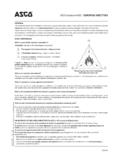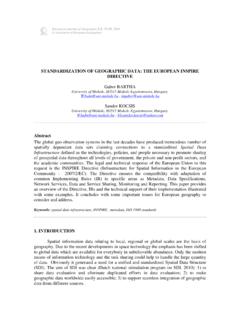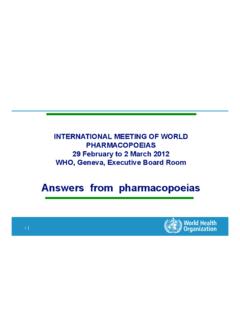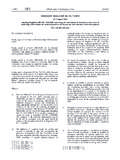Transcription of REACH - Exemptions
1 REACH - Exemptions UK REACH Competent Authority Information Leaflet Number 8 Exemptions July 2016 If you have responsibilities under REACH then you need to know what impact this might have on your business. This leaflet explains the way REACH excludes some chemicals from its provisions. What is REACH ? REACH (Registration, Evaluation, Authorisation and restriction of Chemicals) is the system for controlling chemicals in Europe. It became law in the UK on 1 June 2007. One of the biggest changes REACH brings about is to move away from concentrating only on chemicals we already know are dangerous, and instead think about a much wider range of substances including ones that we don t yet know enough about. This leaflet aims to help you understand which chemicals are covered by REACH , and which are exempt from all or parts of it.
2 It is intended to be a starting point to help you understand the extent to which REACH might impact on the chemicals in your business. REACH covers most chemical substances that are manufactured in or imported into the EU. This can be: Substances on their own Substances in a mixture (a preparation or formulation; for example, ink or paint) Substances that make up an article (essentially, an object that is produced with a special shape, surface or design) Substances do not need to be registered under REACH if they are manufactured or imported at less than 1 tonne per year, per manufacturer/importer. Some substances are exempt from all or certain aspects of REACH ( partial Exemptions ). The following describes what substances are exempt from which parts of REACH . Total Exemptions Substances which fall into any of the categories below are totally exempted from the requirements of REACH [reference: REACH Article 2(1), (2) and (3)]; Radioactive substances within the scope of Council Directive 96/29/Euratom; Substances, on their own, in a mixture or in an article, which are subject to customs supervision, provided that they do not undergo any treatment or processing, and which are in temporary storage, or in a free zone or free warehouse with a view to re-exportation, or in transit; Non-isolated intermediates; The carriage of dangerous substances and dangerous substances in dangerous mixtures by rail, road, inland waterway, sea or air; Waste as defined in Directive 2006/12/EC.
3 European Union Member States can also create specific Exemptions in the interest of defence. In the UK the Ministry of Defence (MoD) will be responsible for issuing these Exemptions . They should be contacted directly for advice on using this exemption . Partial Exemptions In addition to those substances which are totally exempt from REACH , there are a number of substances which are exempt from only certain aspects of REACH . This is often because they are used in products which fall under the scope of more specific legislation. These are listed below together with the relevant article of the REACH text and the part of REACH from which they are exempt. 1. Substances contained within products falling into scope of the following European Directives and Regulations are exempted from the following parts of REACH : Title II (Registration); Title V (Downstream Users); Title VI (Evaluation); Title VII (Authorisation) REACH - Exemptions UK REACH Competent Authority Information Leaflet Number 8 Exemptions July 2016 Medicinal products [Article 2(5)(a)]; o for human use within the scope of Directive 2001/83/EC; o for veterinary use within the scope of Regulation (EC) No 726/2004, Directive 2001/82/EC.
4 Food and Feedingstuffs in accordance with Regulation (EC) No 178/2002 [Article 2(5)(b)]; including use o as a food additive in foodstuffs within the scope of Directive 89/107/EEC; o as a flavouring in foodstuffs within the scope of Directive 88/388/EEC and Directive 1999/217/EC drawn up in application of Regulation (EC) No 2232/96; o as an additive in feeding stuffs within scope of Regulation (EC) No 1831/2003; o in animal nutrition within the scope of Directive 82/471/EEC. 2. Substances contained within products in the finished state, intended for the end user, falling into scope of the following European Directives and Regulations are exempted from the following Parts of REACH : Title IV (Information in the supply chain) [Article 2(6)] Medicinal products (as per the bullet point above); Cosmetic products as defined in Directive 76/768/EEC; Medical devices which are invasive or used in direct physical contact with the human body in so far as Community measures lay down provisions for the classification and labelling of dangerous substances and mixtures which ensure the same level of information provision and protection as Directive 1999/45/EC; Food and Feedingstuffs (as per the bullet point above).
5 3. As described in Article 2(7), there are further groups of substances exempted from the following Parts of REACH : Title II (Registration); Title V (Downstream Users); Title VI (Evaluation). These groups are: i) Substances covered by Annex IV or V: Substances specifically named in Annex IV, as sufficient information is known about the intrinsic properties of these substances that they are considered to cause minimum risk; Substances covered by Annex V, as registration is deemed inappropriate or unnecessary for these substances and their exemption from these Titles does not prejudice the objectives of this Regulation. Further details of Exemptions covered by Annex V are given in the following section; ii) Substances on their own or in mixtures, which have been registered, that are exported from the Community by an actor in the supply chain and then re-imported into the Community by the same or another actor in the same supply chain who shows that: the substance being re-imported is the same as the exported substance; he has been provided with the information in accordance with Articles 31 or 32 of REACH relating to the exported substance.
6 Note: the advice of the European Commission and the European Chemicals Agency is that this exemption applies only when a substance has been fully registered. It would not apply to the re-import of pre-registered substances and the re-importing company may need their own pre-registration. iii) Substances, on their own, in mixtures or in articles, which have been registered, which are recovered ( recycled) in the Community if: the substance that results from the recovery process is the same as the substance that has been registered; and the information required by Articles 31 or 32 of REACH relating to the substance that has been registered is available to the establishment undertaking the recovery. REACH - Exemptions UK REACH Competent Authority Information Leaflet Number 8 Exemptions July 2016 Article 31 relates to the requirements for Safety Data Sheets; Article 32 relates to the duty to communicate information down the supply chain for substances on their own or in mixtures for which a Safety Data Sheet is not required.
7 Note: the advice of the European Commission and the European Chemicals Agency is that this exemption applies only when a substance has been fully registered. It would not apply to recovered substances that have only been pre-registered. Many substances that are recovered, , metals, solvents, etc were registered in 2010. 4. On-site isolated intermediates and transported isolated intermediates shall be exempted from Chapter 1 of Title II (Registration), with the exception of Articles 8 and 9; and Title VII - Authorisation. (Article 2 (8)) Chapter 1 of Title II refers to the General Obligation to register and information requirements, Article 8 refers to Only Representatives and Article 9 to Exemptions from the general obligation to resister for product and process orientated research and development.
8 There are special registration provisions for on-site isolated intermediates and transported isolated intermediates in Articles 17 and 18 of REACH . These can be used if the substances are handled under the specified Strictly Controlled Conditions. 5. The provisions of Titles II (Registration) and VI (Evaluation) shall not apply to polymers (Article 2(9)). However the monomers or other substances within the polymer will require registration if they meet both the following criteria and have not already been registered by somebody higher up your supply chain: o the polymer consists of 2 % weight by weight (w/w) or more of such monomer substance(s) or other substance(s) in the form of monomeric units and chemically bound substance(s); o the total quantity of such monomer substance(s) or other substance(s) makes up 1 tonne or more per year.
9 Note: the advice of the European Commission and the European Chemicals Agency is that this exemption applies only when a substance has been fully registered and does not exempt the monomers or other substances used to make the polymer from pre-registration. 6. Substances used in product and process-oriented research and development (PPORD) (Article 9). A substance which is manufactured in or imported into the EU for the purposes of product and process orientated research and development is exempt from certain aspects of Registration for a period of 5 years, providing the manufacturer applies to the European Chemicals Agency for this exemption . Further details of how to do this and what Exemptions apply can be found in Article 9 of REACH . 7. Substances used as active substances in Plant Protection Products and Biocidal Products (Article 15).
10 Substances manufactured in or imported into the EU which are used as active substances within Plant Protection or Biocidal Products are deemed to be registered under REACH . These substances must appear on Annex I of the Plant Protection Products Directive (91/414/EC) or Annex I, IA or IB or the Biocidal Products Directive (98/8/EC) or be in the review programme of the relevant Directive. Non active substances and non Plant Protection/Biocidal uses of active substances are subject to the requirements of REACH . Annex V Exemptions There are several parts of Annex V which give generic Exemptions to substances that meet certain criteria. Details of these are given below: 1. The following substances which occur in nature, if they are not chemically modified: Minerals, ores, ore concentrates, raw and processed natural gas, crude oil, coal.















